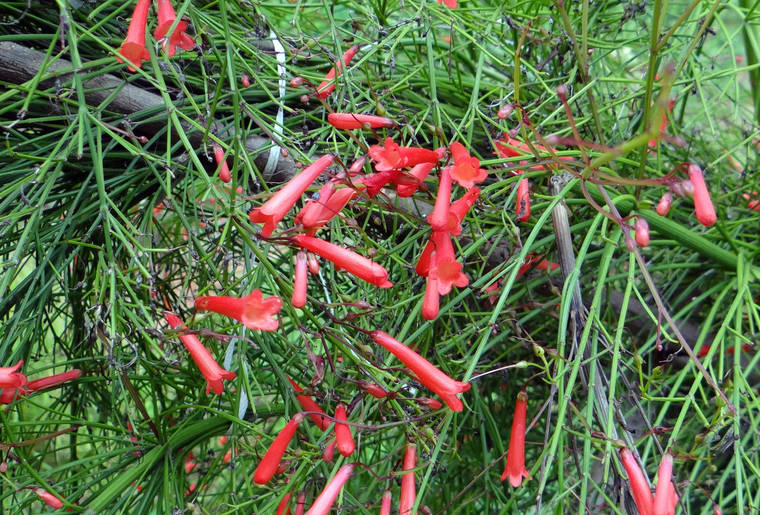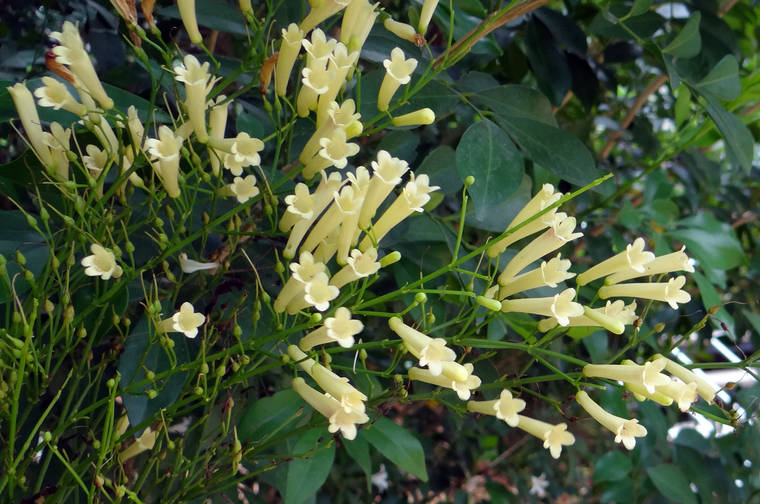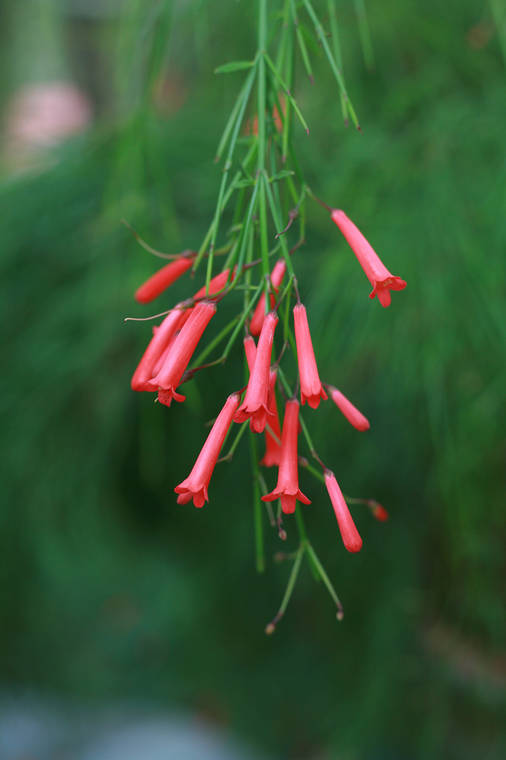By now, you are probably tired of the pop, bang, boom of those expensive New Year’s fireworks down the street. Maybe you are ready to put a quieter, more attractive firecracker in your garden. Looking like a burning sparker, a firecracker plant can add an exciting visual effect to your landscape without the noise.
The plant is named appropriately. It appears as a blast of spikey green stems festooned with lots of small fiery red-orange flowers. Other common names are almost as appropriate. They include fountain bush and coral fountain. It also has a Hawaiian name, lokalia.
The cigar plant (Cuphea ignea) is sometimes referred to as firecracker plant but the two should not be confused. Lokalia is larger and has a more arching growth habit. Both plants attract butterflies, however, and are sometimes grown together.
Knowing a plant’s botanical name can be important when plants share common names. Our firecracker’s botanical name Russelia equisetiformis honors the eighteenth century Scottish naturalist Alexander Russel. The species name refers to its resemblance to horsetail rushes (Equisetum).
R. equisetformis is a low growing shrub in the Scrophulariaceae (Snapdragon) family. The Hawaiian native bacopa as well as the lovely torenia are close relatives to this firecracker. Her arching stem can reach nearly 6 feet sporting bright one-inch tubular flowers that bloom year round. Though the stems do produce tiny leaves, they drop quickly forcing the stems to take over the job of photosynthesis.
The more than 50 species in the Russelia genus are all native to the American tropics. Firecracker is native to Mexico and was not introduced to Hawaii until 1851 as part of a shipment from Australian botanical gardens. It has become popular here in landscaping as a ground cover, in rock gardens or spilling down hillsides and banks. It also makes an attractive specimen cascading over retaining walls or the sides of a hanging basket.
Firecracker plants are classified herbaceous sub-shrubs. Though their arching, bright green stems can grow quite long under ideal conditions, their flexibility manages to keep the plant under 4 feet. As the plant matures, some of the older stems may thicken and become more woody though still flexible.
The ease of propagation adds to firecracker’s popularity. New plants can be produced from either seeds or cuttings. Cuttings of 4 to 6 inches dipped in a rooting hormone and placed in a damp medium of half vermiculite and half perlite can produce a new plant quickly. Kept the medium moist and the cuttings should develop roots, produce new leaves and be ready to plant in the garden in a month or two.
The firecracker produces tiny light brown seeds following flowering. If not collected the plant will likely self-sow. Pruning spent flowers can prevent seeding and encourage a flush of new flowers. If you want to save the seeds, however, bag the seed heads when they appear and collect the bags once the seeds fall from the plant. Store in bags that allow for good airflow so the seeds don’t mold or rot.
You can plant the tiny seeds in a seeding mix or directly in the garden. Bury them under about a quarter inch of loose soil and keep them moist until they sprout. You may need to thin the seedlings but once you have a few strong single plants at least six inches tall, they can survive on less water. Water a few times a week until they are well established. Be sure they are in soil that drains well at all times.
Firecracker plants will produce lush growth and a profusion of flowers in full sun. They can tolerate partial shade but will produce weaker stems and fewer flowers. Adult firecracker plants are fine with one deep watering weekly. Growing them in soil that has good drainage will prevent root rot if they are over watered. They are an ideal choice for a xeriscape garden at lower elevations.
Firecracker plants are nearly maintenance free. Discretionary pruning to shape the plant and keep it compact is really all that is needed. Light fertilizing several times a year can encourage stem growth and flowering. Though firecrackers do not usually attract pests, over fertilizing or over watering can make them more vulnerable to insect or disease attacks.
Though firecracker varieties with pale orange or cream-colored flowers are available, the red-orange is recommended as an eye-catching garden addition. All of the varieties have the same cascading growth habit that can be used to hide unattractive spots in the garden. Their presence can attract butterflies and hummingbirds to your garden as well.
Firecracker plant’s many attractive feature makes it a good choice for gardeners seeking to add easy care brilliance to their landscape. Her lovely arching foliage, bright red-orange flowers as well as her tolerance for drought, wind and salt make firecracker an excellent plant for Kona gardens.
Diana Duff is a plant adviser, educator and consultant living part time in Kailua-Kona.
Gardening Events
Every Saturday: “Work Day at Amy Greenwell Garden” from 9 a.m. to 12:30 p.m. Meet at the Garden Visitor Center across from the Manago Hotel in Captain Cook. Come with a mask and be prepared to practice social distancing. Volunteers can help with garden maintenance anad are invited to bring a brown bag lunch. Water and snacks provided. Call Peter at 323-3318 for more information.
Jan. 16: “Intro to Beekeeping Virtual Workshop” from 9 a.m. to noon. Offered by the California Master Beekeeper Program. The first in a series of seven classes. This Class is $25. Register for the series of classes to get a 10% discount. Register at https://registration.ucdavis.edu/Item/Details/694. More information at: https://cambp.ucdavis.edu/. Direct questions to their email at camasterbee@gmail.com
Farmer Direct Markets – check websites for new hours and online markets
Wednesday: “Hooulu Farmers Market” at Sheraton Kona Resort & Spa at Keauhou Bay
Saturday: “Keauhou Farmers Market,” 8 a.m. to noon at Keauhou Shopping Center. More info: www.keauhoufarmersmarket.com/onlinemarket
“Kamuela Farmer’s Market,” 7:30 a.m. to noon at Pukalani Stables
“Waimea Town Market,” 7:30 a.m. to noon at the Parker School in central Waimea
“Waimea Homestead Farmers Market” from 7:30 a.m. to noon at the Waimea middle and elementary school playground
Sunday: “Pure Kona Green Market” 9 a.m. to 2 p.m. at Amy Greenwell Garden in Captain Cook
“Hamakua Harvest,” 9 a.m. to 2 p.m. at Highway 19 and Mamane Street in Honokaa
Plant Advice Lines
Call 322-4892 to see when they will be back in full service.








